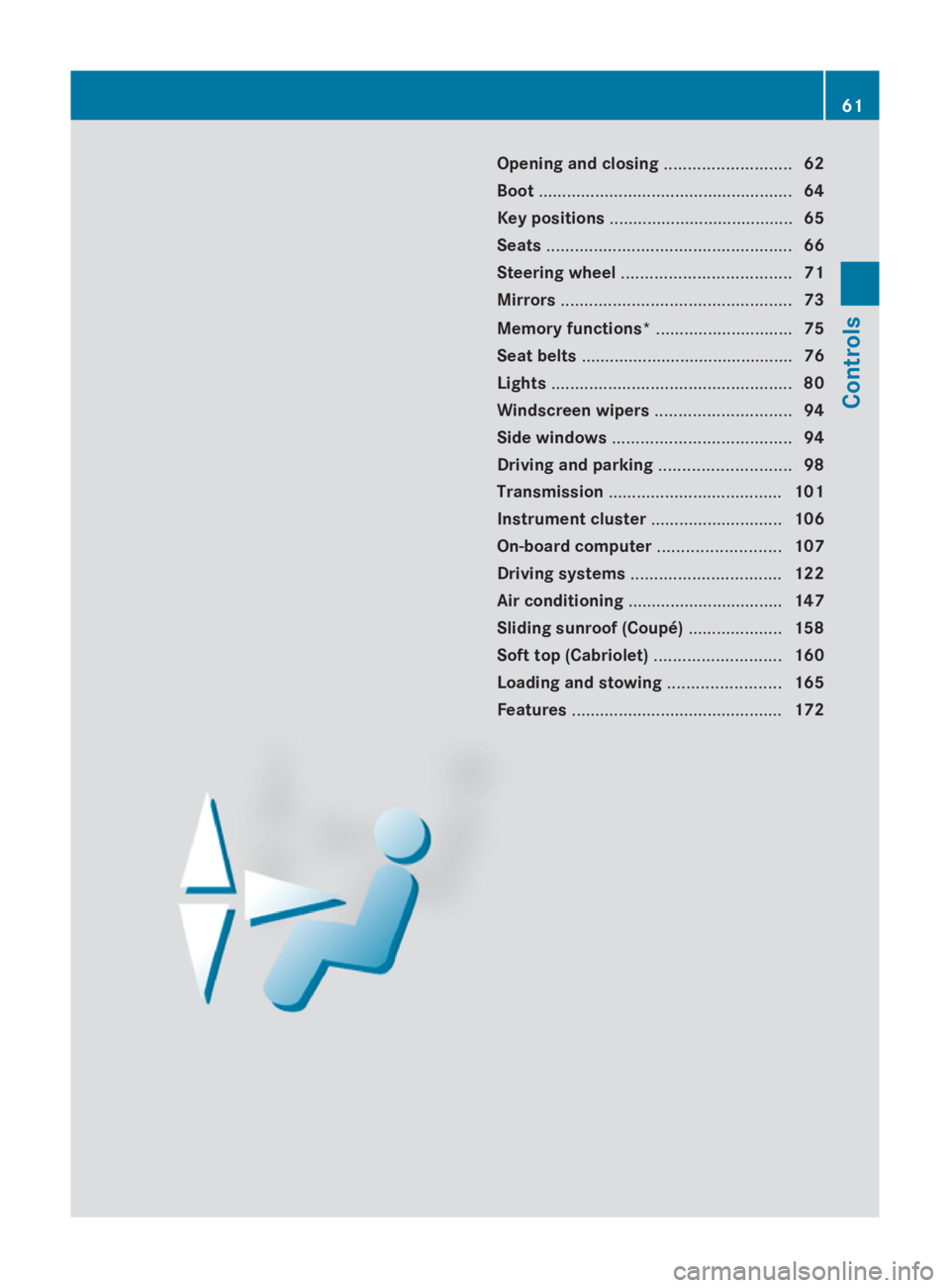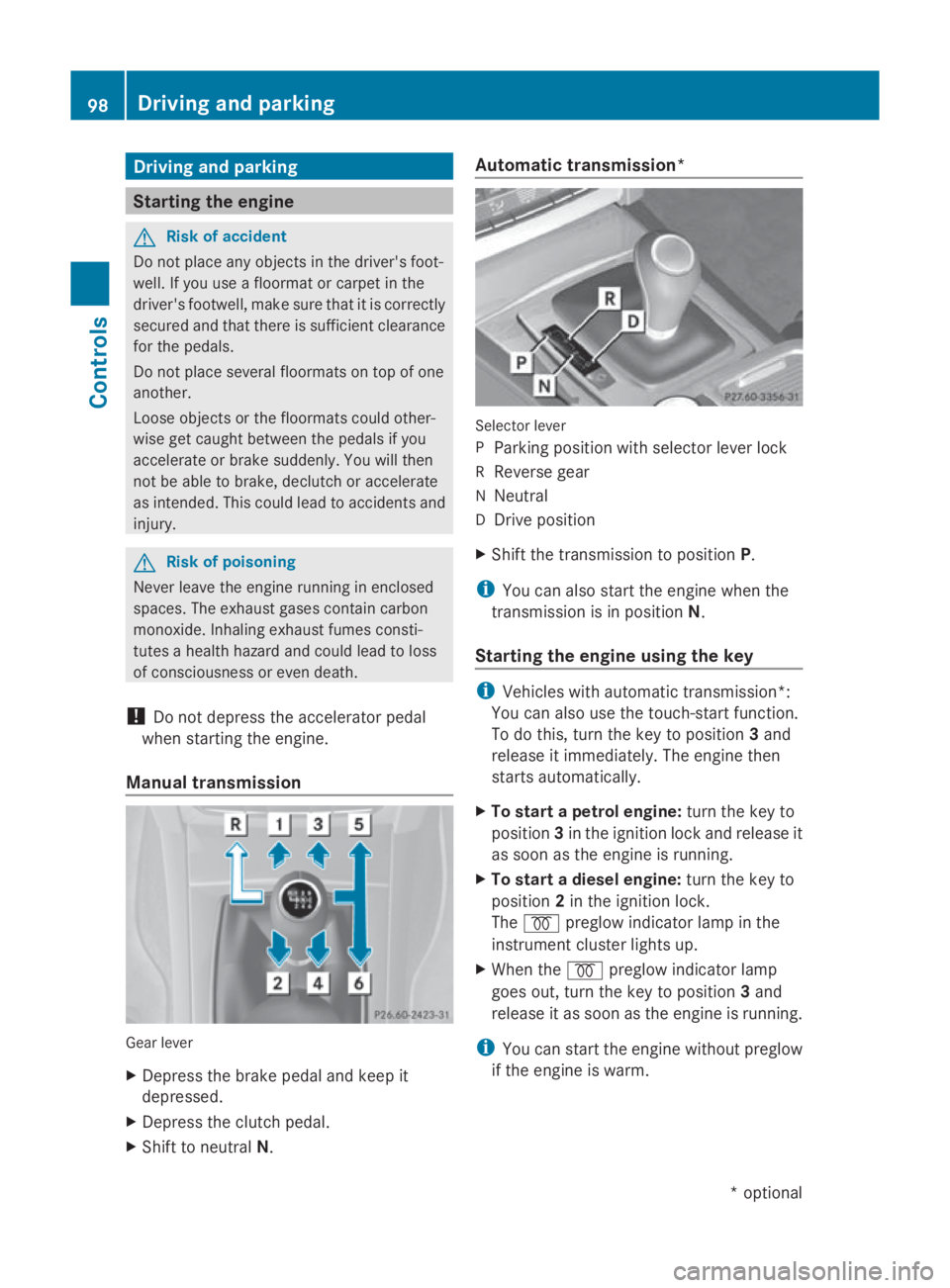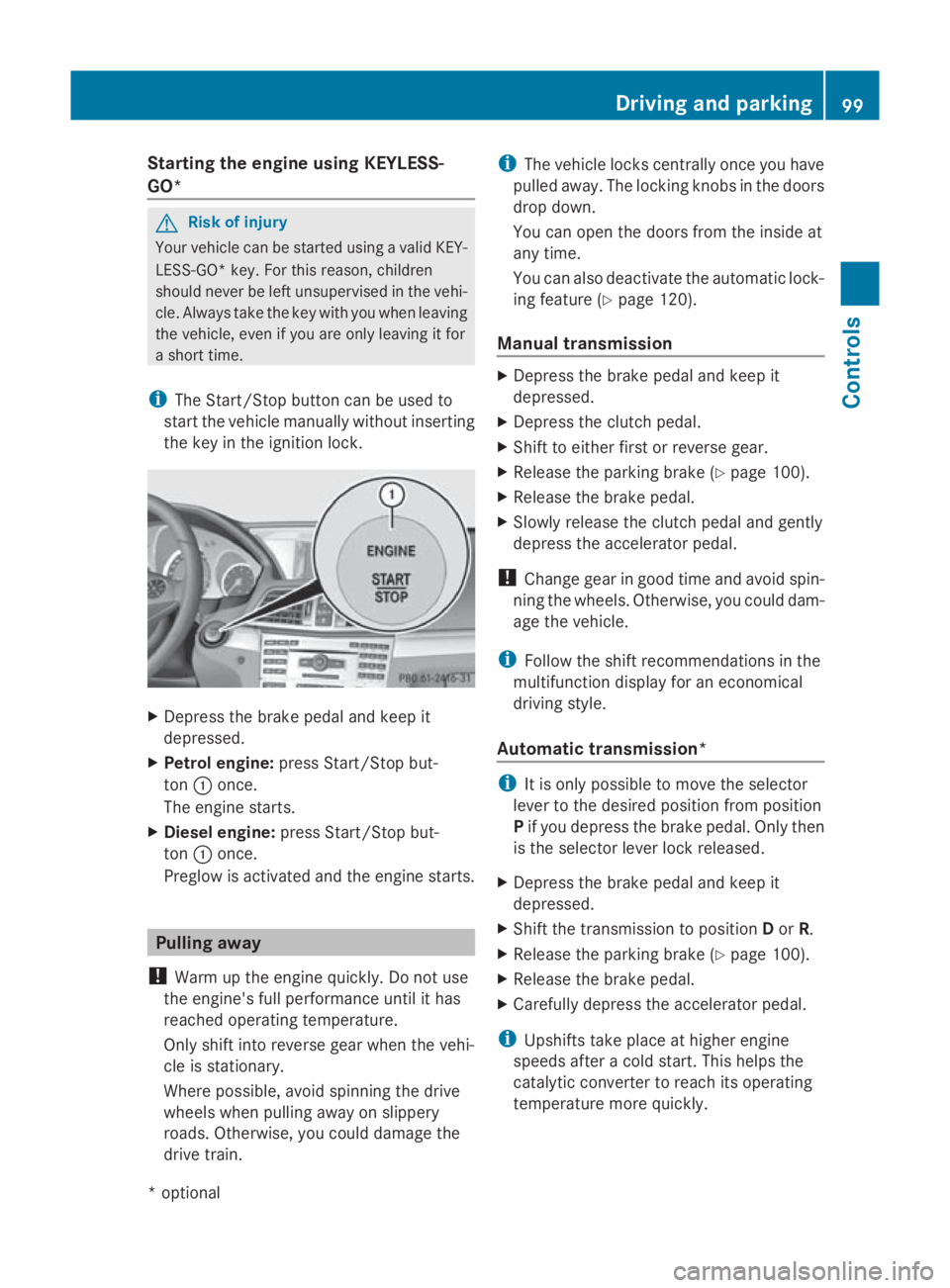2009 MERCEDES-BENZ E-CLASS COUPE parking
[x] Cancel search: parkingPage 64 of 313

Opening and closing
...........................62
Boot ...................................................... 64
Key positions ....................................... 65
Seats .................................................... 66
Steering wheel .................................... 71
Mirrors ................................................. 73
Memor yfunctions* ............................. 75
Seat belts ............................................. 76
Lights ................................................... 80
Windscreen wipers .............................94
Side windows ...................................... 94
Driving and parking ............................98
Transmission ..................................... 101
Instrument cluster ............................106
On-boar dcomputer .......................... 107
Driving systems ................................ 122
Air conditioning ................................. 147
Sliding sunroof (Coupé) ....................158
Soft top (Cabriolet) ...........................160
Loading and stowing ........................165
Features ............................................. 172 61Controls
207_AKB
;2;3,en-GB
mkalafa, Version:2.11.8.1
2009-07-23T10:23:49+02:0
0-Seite 61
Page 65 of 313

Opening and closing
Key
The key centrally locks/unlocks:
R the doors
R the boot lid
R the fuel filler flap G
Risk of accident
If children are left unsupervised in the vehicle,
they could:
R open adoor from the inside at any time,
even if it has been locked
R start the vehicle using akey which has been
left in the vehicle
R release the parking brake
They could thereby endanger themselves and
others. Never leave children unsupervised in
the vehicle. Always take the key with you
when leaving the vehicle, even if you are only
leaving it for ashort time. 0046
0037 Locksthe vehicle
0047 0054 Unlocks the boot lid
008A 0036 Unlocks the vehicle
0088 Battery chec klamp
When unlocking, the turn signals flash once.
When locking, they flash three times.
The vehicle relock sautomatically if you do not
open adoor or the boot lid within 40 seconds
of unlocking the vehicle. The time until it locks
is approximately 40 seconds. KEYLESS GO* You can start
,lock or unlock the vehicle using
the KEYLESS GO key. To do this, you only
need carry the key with you. When you touch
the surface of the sensor sonthe vehicle's
door handles, KEYLESS GO establishes a
radio connection between the vehicle and the
key.
The distanc etothe door handle from which
you wish to lock or unlock the vehicle must
not be greater than 1m.
When starting the engin eand whilst driving,
KEYLESS GO also checks whether avalid key
is in the vehicle by periodically establishing
radio contact. X
To unlock the vehicle: touch the inner
surface of the door handle.
X To lock the vehicle: touch sensor sur-
face 0046.
If you pull the boot lid handle, only the boot
of the vehicle is unlocked.
i If the vehicle has been parked for along
time, you must pull the door handle to acti-
vate KEYLESS GO.
Individua lsettings You can change the setting of the locking
system in such
away that only the driver's
door and the fuel filler flap are unlocked. This
could be useful if you frequently travel on your
own.
X To change the setting: press the0036
and 0037 button ssimultaneously for 62
Opening and closingControls
*o
ptional
207_AKB
;2;3,en-GB
mkalafa, Version:2.11.8.1
2009-07-23T10:23:49+02:00
-Seite 62
Page 78 of 313

Memory functions*
Storing settings
Using the memory button you can store up to
three different settings, e. g. for three differ-
ent people.
The following settings are stored as asingle
memory preset:
R position of the seat, backrest and head
restraint
R driver's side :steering whee lposition
R driver's side :position of the exterior mir-
rors on the driver's and front-passenger
sides G
Risk of injury
The memory function can still be use dwhen
the key has been removed .For this reason,
children should never be left unsupervised in
the vehicle. Otherwise, they coul dbecome
trappe dwhen moving the seat or the steering
wheel. G
Risk of accident
Only use the memory function on the driver's
side when the vehicl eisstationary. Other-
wise, you coul dbedistracted from the traffic
conditions by the steering whee land seat
moving of their own accord, and as aresult
caus eana ccident. X
Adjust the seat( Ypage6 6).
X On the driver's side ,alsoa djust the steer-
ing whee l(Y page7 1) and the mirrors
(Y page7 3).
X Press memory button Mand press storage
position switch 1,2or 3withi nthree sec-
onds.
The settings are stored in the selected pre-
set position. Atone sound swhen the set-
tings have been completed. Calling up
astored setting
X Press the corresponding storage position
button 1,2or 3.
The seat, steering whee land exterior mirror
are set in the stored position.
i The setting procedure is interrupted as
soon as you release the storage position
switch. Parking position for the exterior mir-
ror on the front-passengers
ide*
To make it easier to park, you can set and
store the front-passenge rside exterior mirror
position in such awaythat you can see the
rear whee lonthat side as soon as you engage
reverse gear.
Setting and storing the parking position Memory functions*
75Controls
*o
ptional
207_AKB; 2; 3, en-GB
mkalafa,
Version: 2.11.8.1 2009-07-23T10:23:49+02:00-Seite 75 Z
Page 79 of 313

X
Make sure that the vehicle is stationary and
that the key is in position 2in the ignition
lock.
X Press button 0047for the exterior mirror on
the front-passenger side.
X Engage reverse gear.
The exterior mirror on the front-passenger
side moves to the preset parking position.
X Use adjustment button 008Ato adjust the
exterior mirror to aposition which allows
you to see the rear wheel and the kerb.
The parking position is stored.
i If you shift the automatic transmission
into another gear, the exterior mirror on the
front-passenger side returns to the driving
position.
i You can also store the parking position
using the memory button M0088:
X With the key in position 2in the igni-
tion lock and with the exterior mirror
on the front-passenger side activated,
use adjustment button 008Ato set the
exterior mirror such that the rear
wheel and kerb are visible.
X Press memory button M0088 and one of
the arrows on adjustment button 008A
within three seconds.
The parking position is stored if the
exterior mirror does not move.
If the mirror moves out of position, repeat
the steps.
Calling up the parking position X
When the key is in position 2in the ignition
lock and the exterior mirror on the front-
passenger side is activated, engage
reverse gear.
The exterior mirror on the front-passenger
side moves to the stored parking position.
The exterior mirror on the front-passenger
side moves back to its original position: R
as soon as you exceed aspeed of
10 km/h
R about ten seconds after you have disen-
gaged reverse gear
R if you press button 0046for the exterior mir-
ror on the driver's side Seat belts
Wearing seat belts
Seat belts are the most effective means of
restraining the movement of vehicle occu-
pants in the event of an accident. This
reduces the risk of vehicle occupants coming
into contact with the vehicle interior. G
Risk of injury
As eat belt which is not worn correctly, or
which has not been engaged in the seat belt
buckle correctly, cannot perform its intended
protective function. Under certain circum-
stances, this could result in severe or even
fatal injuries.
Make sure that all occupants –inparticular,
pregnant women –wear their seat belt cor-
rectly at all times.
R The seat belt must fit snugly on your body
and must not be twisted. Therefore, you
should avoid wearing bulky clothing (e.g. a
winter coat). The shoulder belt section
must be routed across the centre of your
shoulder –onnoaccount across your neck
or under your arm –and pulled tight against
your upper body. The lap belt must always
pass across your lap as low down as possi-
ble, i.e. over your hip joints–n ot across
your abdomen. If necessary, push down the
belt strap slightly and then retighten it in
the roll-up direction.
R Do not route the belt strap across sharp
edges or fragile objects, especially if these
are located on or in your clothing, e.g. spec-
tacles, pens, keys, etc. The seat belt strap
could be damaged and tear in an accident, 76
Seat beltsControls
207_AKB; 2; 3, en-GB
mkalafa,
Version: 2.11.8.1 2009-07-23T10:23:49+02:00-Seite 76
Page 84 of 313

tries
,ope ratio noft he headlamps varies due
to lega lrequirements and self-impose dobli-
gations. In these countries ,the daytime driv-
ing lights ar eautomaticall yswitched on when
the engine is started.
Th ee xterior lighting (excep tthe side lamp/
parking lamp) switches off automaticall yif
you:
R remove the key fro mthe ignition lock
R open the driver's door when the ignition is
switched off (ke yinposition 0in the igni-
tio nlock)
! Switch off the side lamps and parking
lamp when yo uleave the vehicle. This pre-
vents the battery fro mdischarging.
Informatio nabout drivin gabroad Converting to symmetrica
ldipped beam
when drivin gabroad: switch the headlamps
to symmetrical dipped beam in countries in
which traffi cdrives on the opposite side of the roa
dtot he country where the vehicl eisreg-
istered. This prevents oncoming traffi cfrom
being dazzled.
Have the headlamps converte dataqualified
specialis tworkshop ,e.g.aM ercedes-Benz
Service Centre, as close to the borde raspos-
sibl ebefor ed riving in these countries .Sym-
metrica llight sdon ot illuminate as large an
area of the edge of the carriageway.
Converting to asymmetrica ldipped beam
afte rreturning: have the headlamps conver-
ted back to asymmetrica ldippe dbeamata
qualifie dspecialis tworkshop ,e.g.a
Mercedes-Benz Service Centre, as soon as
possibl eafter crossing the borde rwhen
returning.
Vehicle swithI ntelligent Light System*: if
the headlamps ar econverte dtosymmetrical
dipped beam ,not al llight functions ar eavail-
able ."Mo torway mode" and the "extended
range foglamps "aredeactivated
(Y page 119). Operation
Light switch
004A
006F
Left-hand parking lamp 004B
0070
Right-hand parking lamp 004C
0027
Lights off/daytime driving
lights Operation
004D
0066
Automatic headlamp mode/
daytime driving lights 004E
006C
Sidelam ps,licence plate and
instrument lighting 004F
0064
Dipped-bea mheadlam ps/
main-bea mheadlam ps18 18
Youm usts witch on the dipped-beam headlamps befor eyou can switch on the main-bea mheadlam ps. Lights
81Controls
*optional
207_AKB; 2; 3, en-GB
mkalafa
,V ersion: 2.11.8.1
2009-07-23T10:23:49+02:00
-Seite 81 Z
Page 90 of 313

Exterio
rlighting (Cabriolet)
Notes on th eexterio rlighting For reason
sofsafety, Mercedes-Ben zrecom-
mends that you driv ewith th elight sswitched
on even durin gthe daytime. In som ecoun-
tries, operatio noftheheadlamps varies due
to legal requirements and self-impose dobli-
gations. In these countries, th edaytime driv-
ing light sare automatically switched on when
th ee ngineiss tarted.
The exterio rlighting (excep tthe side lamp/
parking lamp) switches off automatically if
you:
R remove th ekeyfrom th eignition lock
R open th edriver' sdoor when th eignition is
switched off (ke yinposition 0in th eigni-
tio nlock)
! Switch off th eside lamps and parking
lamp when you leave th evehicle .This pre-
vents th ebattery from discharging.
Information abou tdriving abroad Convertin
gtosymmetrica ldipped beam
when driving abroad: switch theheadlamps
to symmetrical dipped beam in countries in whic
htraffic drives on th eopposite side of the
road to th ecountr ywherethe vehicle is reg-
istered .This prevents oncoming traffic from
bein gdazzled.
Hav ethe headlamps converte dataqualified
specialist workshop ,e.g.aM ercedes-Benz
Servic eCentre, as close to th eborder as pos-
sible before driving in these countries. Sym-
metrical light sdonotilluminate as large an
area of th eedge of th ecarriageway.
Convertin gtoasymmetrical dipped beam
after returning: have theheadlamps conver-
te db ack to asymmetrical dipped beam at a
qualifie dspecialist workshop ,e.g.a
Mercedes-Ben zServic eCentre, as soon as
possible after crossing th eborder when
returning.
Vehicles with Intelligent Light System*: if
th eh eadlamps are converte dtosymmetrical
dipped beam, no tall light function sare avail-
able. "Motorway mode "and th e"extended
range foglamps "are deactivated
(Y page 119). Operation
Light switch
004A
006F
Left-han dparking lamp 004B
0070
Right-hand parking lamp Operation
004C
006C
Sidelamps ,licenc eplatea nd
instrumen tlighting 004D
0066
Automatic headlam pmode/
daytime driving lights Lights
87Controls
*optional
207_AKB
;2;3,en-GB
mkalafa, Version:2.11.8.1
2009-07-23T10:23:49+02:00
-Seite 87 Z
Page 101 of 313

Drivin
gand parking Starting th
eengine G
Risk of accident
Do no tplac ea ny objects in th edriver's foot-
well. If you use afloormat or carpet in the
driver's footwell, mak esuret hatitisc orrectly
secure dand that there is sufficien tclearance
fo rt he pedals.
Do no tplac es evera lfloormat sontopof one
another.
Loose objects or th efloormat scould other-
wise get caught between th epedals if you
accelerat eorbrake suddenly. You will then
no tbea ble to brake ,declutch or accelerate
as intended. Thi scould lead to accidents and
injury. G
Risk of poisoning
Never leav ethe engin erunning in enclosed
spaces. The exhaus tgases contain carbon
monoxide. Inhaling exhaus tfumes consti-
tute sah ealth hazard and could lead to loss
of consciousness or eve ndeath.
! Do no tdepress th eaccelerator pedal
when startin gthe engine.
Manual transmission Gear lever
X
Depress th ebrake peda land keep it
depressed.
X Depress th eclutc hpedal.
X Shift to neutral N. Automatic transmission*
Selecto
rlever
P Parking position wit hselecto rlever lock
R Revers egear
N Neutral
D Drive position
X Shift th etransmissio ntoposition P.
i You can also start th eenginew hen the
transmissio nisinpositionN.
Starting th eengin eusing th ekey i
Vehicles wit hautomatic transmission*:
You can also use th etouch-start function.
To do this, turn th ekeyto position 3and
release it immediately. The engin ethen
start sautomatically.
X To star tapetrolengine: turn thekeyto
position 3in th eignition loc kand release it
as soo nastheengin eisrunning.
X To star tadiesel engine: turn thekeyto
position 2in th eignition lock.
The 0028 preglo windicator lamp in the
instrumen tcluster lights up.
X Whe nthe 0028 preglo windicator lamp
goe sout,tur nt he keyt op osition 3and
release it as soo nastheengin eisrunning.
i You can start th eenginew ithout preglow
if th eengineisw arm. 98
Driving an
dpark ingCont rols
*optio nal
207_AKB; 2; 3, en-GB
mkalafa
,V ersion: 2.11.8.1
2009-07-23T10:23:49+02:00
-Seite 98
Page 102 of 313

Starting the engine using KEYLESS-
GO* G
Risk of injury
Your vehicle can be started using avalid KEY-
LESS-GO* key. For this reason, children
should never be left unsupervised in the vehi-
cle. Always take the key with you when leaving
the vehicle, even if you are only leaving it for
as hort time.
i The Start/Stop button can be used to
start the vehicle manually without inserting
the key in the ignition lock. X
Depress the brake pedal and keep it
depressed.
X Petrol engine: press Start/Stop but-
ton 0046once.
The engine starts.
X Diesele ngine:press Start/Stop but-
ton 0046once.
Preglow is activated and the engine starts. Pulling away
! Warm up the engine quickly. Do not use
the engine's full performanc euntil it has
reached operating temperature.
Only shift into reverse gear when the vehi-
cle is stationary.
Where possible, avoid spinning the drive
wheels when pulling away on slippery
roads. Otherwise, you could damage the
drive train. i
The vehicle locks centrally once you have
pulleda way.The locking knobs in the doors
drop down.
You can open the doors from the inside at
any time.
You can also deactivate the automatic lock-
ing feature (Y page 120).
Manual transmission X
Depress the brake pedal and keep it
depressed.
X Depress the clutch pedal.
X Shift to either first or reverse gear.
X Release the parking brake (Y page 100).
X Release the brake pedal.
X Slowly release the clutch pedal and gently
depress the accelerator pedal.
! Change gear in good time and avoid spin-
ning the wheels. Otherwise, you could dam-
age the vehicle.
i Follow the shift recommendations in the
multifunction display for an economical
driving style.
Automatic transmission* i
It is only possible to move the selector
lever to the desired position from position
P if you depress the brake pedal. Only then
is the selector lever lock released.
X Depress the brake pedal and keep it
depressed.
X Shift the transmission to position Dor R.
X Release the parking brake (Y page 100).
X Release the brake pedal.
X Carefull ydepress the accelerator pedal.
i Upshifts take place at higher engine
speeds after acold start. This helps the
catalytic converter to reach its operating
temperature more quickly. Driving and parking
99Controls
*optional
207_AKB; 2; 3, en-GB
mkalafa,
Version: 2.11.8.1 2009-07-23T10:23:49+02:00-Seite 99 Z